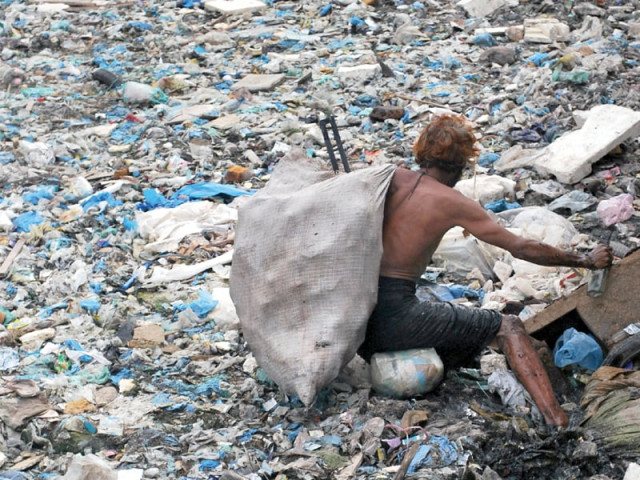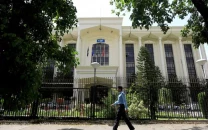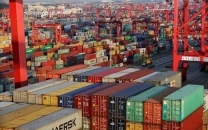Financial machine: Debt-based system and resource-based economies
Poor living standards have more to do with ineffective governance, an inefficient state.

According to the current method, if a person is able to consume 2,350 calories per day, which costs Rs1,745 per month, then the individual is assumed to be living above the poverty line. PHOTO: ARIF SOOMRO/EXPRESS
The existing financial system based on a combination of credit and equity has played an important role in economic growth and development in developed countries of the world.
Despite ups and downs and consequent instability of the system, provision of credit remains a catalyst for economic growth. It has improved overall standards of living but perhaps has not been sufficiently and necessarily helpful in improving financial worth of individuals and families in such countries.
This means that while this interest-based system of debt creation has helped businesses and corporates grow tremendously, individuals and households (the masses) have benefitted from it only marginally. The consequent income disparities are visible in capitalistic economies of the world.
The above point can be illustrated by the following example.
If we randomly select a family in a developed country and compare it with its counterpart in a developing country, we may not find any significant difference in the financial worth of the two families. One possible difference between the two families is in terms of indebtedness. It is likely that an average family in the developed country is more indebted than its counterpart in the developing country.
The table below presents three randomly drawn persons/families from a developed country, and compares them with their exact counterparts in a developing country. Depending on the segment of society from which the person/family is drawn in the developed country, an exact equivalent should then be drawn from the developing country.
For example, if family A is drawn from a low-income segment of society in the developed country, then its exact counterpart could be in a medium-income segment in the developing country. Similarly, if a medium-income family B is drawn from the developed country, it is expected that its rough counterpart will be a high-income (bottom level) family in the developing country.
There may not be much difference between high-income families in the two countries. However, it is realistic to assume that a bottom-level high-income family in the developed country will be equivalent to a top-level high-income family in the developing country. It is expected that comparisons of the three representative persons from the developed country with their counterparts from the developing country will yield different results.
The comparison in the table suggests that in terms of financial worth the medium-income family B in the UK is slightly worse off compared to its exact counterpart family B in Pakistan. Although the family in the UK lives in a more expensive house than the one in Pakistan, it is likely that the former has bought the house by using a mortgage product offered by a bank or building society. Assuming that the family owns only 30% of the equity in the house, it has 90,000 Great Britain Pounds (GBP) worth of equity in the house.
On the other hand, the B family in Pakistan is likely to own the house without any debt obligations related to it. Using the current exchange rate between the two currencies, the Pakistani family has about GBP150,000 worth of equity in the house it lives in.
Similarly, the used car value of the vehicle owned by the British family is only GBP5,000. Its Pakistani equivalent owns a car worth GBP9,000. Based on these assets, the financial worth of the Pakistani family is significantly higher than its British counterpart.
However, the low-income and high-income families in the UK are expected to be better off as compared to their counterparts in Pakistan. This is implied in the comparisons of the A and C families in the two countries.
The overall standard of living in the UK is certainly much higher than that of Pakistan. One may like to conclude from here that the standard of living differential between developed and developing countries is not due to their financial systems but rather because of governance systems and the role of state and its efficiency in the two countries.
It is certainly true that the state is more efficient and helpful in terms of improving overall standard of living in developed countries.

The debt-based financial system that prevails in the developed countries, on the other hand, helps upper segments of society more than the lower segments. When it comes to the median person, the debt-based system is not very helpful as compared to a system that does not provide credit.
One is inclined to conclude that lack of access to credit is not the raison d’etre of poor socio-economic conditions and an inferior standard of living for the masses but rather it has a lot to do with the ineffectiveness of a governance system and inefficiency of the state in building and maintaining social infrastructure in developing countries, including Pakistan.
The writer is an economist and a PhD from Cambridge University
Published in The Express Tribune, September 23rd, 2013.
Like Business on Facebook, follow @TribuneBiz on Twitter to stay informed and join in the conversation.



















COMMENTS
Comments are moderated and generally will be posted if they are on-topic and not abusive.
For more information, please see our Comments FAQ